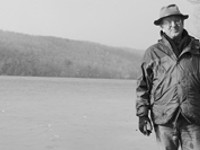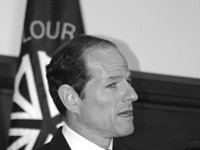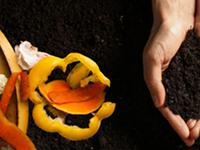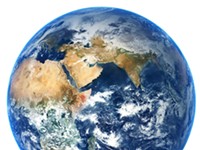[
{
"name": "500x250 Ad",
"insertPoint": "5",
"component": "15667920",
"parentWrapperClass": "",
"requiredCountToDisplay": "1"
}
]
The planet is warming up. What does that mean for Rochester?
The short answer is that nobody really knows.
A climate is a complex thing. Change one little part of it and you may change the whole thing --- and in unpredictable ways. Still, that doesn't mean scientists can't make some sound educated guesses about what could happen. And if any of those guesses prove accurate, the Rochester of tomorrow could be a very different place from the one we know today.
Despite the complexity of all the systems involved, there are a few easy places to begin to understand the effects of climate change in Rochester.
When it comes to deducing what the weather of tomorrow might be like, it's helpful to start with the weather of today. That's where Dr. Jose Maliekal comes in. A professor at Brockport for the past 15 years, Maliekal has a PhD in meteorology, and focuses many of his classes on climatology and climate change. He's careful to point out the inherent uncertainty in making predictions based on current predictions.
Throughout the course of an interview with City Newspaper, he kept adding qualifiers like "You never know these things for sure" and "No one can say for sure." Part of that uncertainty comes from the fact that changing a single variable has the potential to result in multiple outcomes, some of them radically different from one another. Maliekal illustrates what he means with an example:
Say you have a temperature increase. Warming increases evaporation, pumping more moisture into the atmosphere. One of two things could happen to that water vapor. First, it could form low-lying clouds. Those clouds, in turn, would have a cooling effect, blocking radiation from the sun that would otherwise heat things up. In that case, such a change would be self-correcting.
But let's say that instead of forming low clouds, the extra water in the atmosphere forms high clouds. "High clouds tend to have a warming effect," says Maliekal, since they trap existing warmth and let more of the sun's rays in. That "could accelerate the warming trend we have in place," says Maliekal. Instead of self-correcting, the system would be self-reinforcing.
(A process similar to the latter scenario has contributed to the global warming now taking place, Maliekal says. Typically, the earth reflects about 30 percent of the sun's radiation into space. Some of that is reflected off the icy surface of glaciers. With glaciers around the planet receding as temperatures rise, there's less ice to reflect radiation, and more gets absorbed by the planet, further raising surface temperatures.)
It's complex possibilities like this that lead Maliekal to say that "no one can say for sure what is going to happen," before quickly adding "We do, however, have some reasonable hypotheses about what could happen."
So what are those hypotheses? Here's one of the more surprising ones: "Should the climate change, there is the possibility that lake effect would increase," says Maliekal.
Lake-effect snow is produced when there are extreme disparities in temperature between the lake water and the atmosphere above it, he explains. If the LakeOntario is storing more heat from the atmosphere during the spring and summer and losing less during the fall and winter, its overall temperature will be warmer.
That means that, assuming we still get periods of cold arctic air, there's a higher likelihood that the area will experience the temperature disparities that create lake effect snow. (Not everyone agrees with Maliekal on this point. In 2000 the University of Michigan's Peter Sousounis authored a paper suggesting that the temperature could rise high enough that even our cold spells might no longer be cold enough to trigger the lake effect.)
But there are plenty of other changes that are likely to be less pronounced, or less surprising.
Ice cover on the Great Lakes and smaller bodies of water is dwindling, for example. (With the exception of the shallow Erie, the Great Lakes rarely freeze over completely, but cover around the shorelines has been shrinking.) What does that mean? "No one can say for sure," says Maliekal.
The same is true for the yearly hydrological cycles the Great Lakes go through. The lakes tend to swell in the spring, with rains and snowmelt runoff, then ebb to seasonal lows in the autumn months.
"Studies have shown that in recent years there has been a shift in that pattern," says Maliekal. Both the spring rise and the fall drop are happening earlier in the year. And no one's sure what that trend might mean if it continues.
Other likely changes to the local environment come with more obvious consequences. For instance, Maliekal says that Rochester, like the rest of the Great LakesBasin, will become a drier place overall. That will lead to higher extremes, he says. We'll experience both "slightly prolonged droughts and increased flooding."
The higher temperatures and relatively scarcer availability of water will affect agriculture, but it will also affect water levels in the Great Lakes. They could drop by as much as 3 feet in the next 50 years.
That change may, in fact, be the one that has the biggest impact on daily human activity in the Great Lakes basin. Ironically, while ocean shorelines around the world will be encroaching on human settlements as sea levels rise, here in the Great Lakes water levels will likely fall. In fact, Environment Canada, the branch of the Canadian government that tracks these things, estimates that the outflow of the St. Lawrence River, which drains all of the Great Lakes basin, could diminish by as much 20 percent.
The reason for the divergent fate of coastlines between oceans and inland bodies of fresh water like the Great Lakes is that the lakes are well above sea level (LakeOntario's elevation is 243 feet). And they won't receive any outflow from the melting glaciers and polar ice caps that will swell the world's oceans. None of those are in the Great Lakes' watershed.
And while droughts and lower water levels will become the norm, some of the water we still get could become more of a problem, since it will come more often in the form of extreme events, like thunderstorms. That, combined with a drier landscape, will mean more frequent and destructive flooding. With more floods and storms, erosion will become a larger problem than it is today, threatening things like agriculture and the value of waterfront homes.
Lower levels on the Great Lakes could also have an impact on commercial navigation. That in itself won't mean much to Rochester, which hasn't relied on commercial shipping as an important part of our economy in a long time. But the pressures on shipping could have some indirect impacts on this region. Environment Canada warns that dredging channels to keep commercial shipping moving apace might stir up dangerous toxic chemicals. Since plenty of the Great Lakes navigational infrastructure is upstream from Rochester, our community's LakeOntario public water intakes would be at risk.
Lower lake levels in the Great Lakes could also hit one other sector pretty hard: hydroelectric power generation. If water outflows decrease, massive projects like those along the Niagara River and Gorge near Buffalo and along the St. Lawrence in Massena could see their ability to generate power diminished, even while energy demands, if they follow today's trends, continue to spiral upward.
Besides the change in lake levels, there's one other area that stands to see a dramatic impact: the region's flora. In fact, plants are already starting to undergo changes as a result of warming that's already occurred.
Grapes are blooming an average of 6 days earlier than they did in the 1960s, while the average bloom dates for apples has shifted 8 days earlier over the same period. For lilacs, it's four days earlier. (At that rate, we'll be looking at an April Lilac Festival in the not-too-distant future.)
Plant ecologist David Wolfe has witnessed, and in some cases documented, these changes. Wolfe is a professor at Cornell's School of Agriculture, and it shouldn't come as a surprise that farmers are among the most concerned about these trends.
"Agriculture is very dependent on the weather," says Wolfe. "This might be a harmless thing," he adds, but his list of concerns seems to undermines that.
For starters, believe it or not, there's the problem of frost.
"One concern is that if the weather's getting better earlier, you could actually have increased frost damage," says Wolfe. Sound counterintuitive? It's not. While average temperatures are getting warmer, coaxing flowers to bloom earlier, that doesn't mean that extreme temperatures will become any less extreme. (Last week's temperatures that flirted with the freezing mark illustrate his point.)
That means that plants germinating and flowering ever earlier run an increasingly higher risk of being killed or damaged by late spring frosts.
The changing temperatures also hold the potential to play havoc on traditionally cold-weather crops in another way. It's a process called "vernalization." That's a fancy scientific term for something akin to hibernation in some plants.
"They need a certain number of days during the winter where the temperature remains low," says Wolfe. And those days have to be consecutive, not spread out over the course of a winter, Wolfe says. Exactly how many days, and what the threshold temperature is, varies from plant to plant, but the basics remain the same. The plant requires those conditions to produce the hormones it needs. If that doesn't happen, the plant's growth --- and the crop it yields --- can suffer. Apples are one prominent local crop that is subject to this biological requirement.
Blueberries and winter wheat are two other examples. And like the ever-earlier bloom dates, this effect is already happening now.
"For years with warmer winters we get lower apple yields," says Wolfe. "I think this past winter was [mild] enough to have that kind of effect."
The way in which global warming is occurring specifically in Western New York exacerbates this problem. While average temperatures have increased about 1.1 degrees Fahrenheit globally in the past century, they're up by 1.8 degrees here. Look just at winter temperatures, though, and the increase in average temperatures jumps to 2.8 degrees, says Wolfe.
Of course, all that warming isn't all bad. There are a few positive outcomes to be had, like extended growing seasons, which may eventually allow crops historically grown further south to thrive here. And one industry in particular stands poised to reap a good deal of benefits:
"There's anecdotal evidence that this is actually good for grapes," says Wolfe.
While North America has a few native varieties of grape, he notes, these are too sweet to be favored by serious winemakers for anything more than a few novelty wines. Instead, the wine industry favors the traditional European strain of the fruit, vitus vinifera. In the past, that might have been a problem.
"They have a little trouble with our historical winter climate," Wolfe says of the vitus vinifera grape. Temperatures of 12 degrees below Fahrenheit or lower damage the vines of the imported variety, he explains.
"We've had very, very few winters where it got that cold" since the 1970s, says Wolfe. That's about the same time wine production really took off in the Finger Lakes, he says.
Still, the downsides for agriculture probably outweigh the benefits. One reason: in addition to the challenges to plants that are built into their own biology, warming will bring a whole host of changes that they may be ill-equipped to deal with.
One of the gravest potential threats along these lines is invasive species. Insects and plant diseases, which can wipe out species of plants, and other plants species, which can out-compete them, may be able to move into a territory as climatic conditions change.
"Insects, diseases, and weeds that are currently south of us will be with us," says Wolfe.
That's a potential threat to all plant species, but typical agricultural crops may be among the most vulnerable, since "a lot of crop species have been genetically programmed to remain a certain size," explains Wolfe. That genetic programming puts crop plants at a disadvantage when competing with wild plants, which can rapidly adapt to changing conditions.
To make matters worse, "weeds will benefit a lot from warming temperatures" and higher levels of carbon dioxide, says Wolfe. "People would have to use more herbicide, since weeds would be healthier," he adds, a practice that has its own environmental effects.
Another possible problem for plants is the change in precipitation patterns.
"It's more difficult to predict precipitation than temperature," says Wolfe. Like Maliekal, he expects to see a general decrease in store for this region, with the exception of extreme events during the summer months.
"Although you might get the same amount of water as in the past, if you get it all in a few chunks you could see some short-term droughts," he says. And in areas that are outside the lake-effect belt, a decrease in snow cover could deprive the soil of insulation. That's means more freezing and thawing through out the course of the winter. While that's not good for plants, it could be even more disruptive for microbes that live in the soil. Their complex relationship with plants who share their soil is still a mystery.
"We don't really know what it does, but it has an impact," he says.
Yet another potential problem for plants is the increased heat itself. Plants, especially cold-weather crops, can suffer from something called "heat stress," which as the name implies, weakens the plant and can potentially reduce crop yields. It also means the plants will require more water, hence more irrigation, even while supplies of the precious resource will be dwindling.
(Although not as well versed on the animal side of farming, Wolfe says that the dairy industry will face similar problems, since cattle like a cool climate and are also vulnerable to heat stress. Temperatures between 45 and 70 degrees Fahrenheit are optimal for milk production. "Farmers can probably adapt," he says, "but it becomes expensive.")
All this potential for change is troubling, since all of us depend on agriculture for our food.
Food costs may go up a bit, but Wolfe says he doesn't foresee huge price spikes. And some food production may actually come back to the area for a variety of reasons. In addition to higher fuel costs, which may make shipping fruit from California (not to mention New Zealand) less profitable, our area will have relatively more water than many other breadbasket regions.
And as the temperature continues to inch upward, crops' ranges will swing northward. (How does a nice crate of Finger Lakes oranges sound?) While many of us will not see such changes in our lifetimes, that doesn't mean farmers can ignore them for now.
"Farmers are going to have to adapt," which may include making expensive investments in new equipment, says Wolfe. "Farmers who are growing cabbage today might be growing something else."
That sounds fine in theory, but at some point farmers are going to have to make the leap from one crop to another, and the process could be messy. Farmers will essentially have to make guesses about whether to change crops and when.
"Some will guess right and some would guess wrong," he says. Those decisions may await farmers in the not-to-distant future, perhaps in as little as 10 to 20 years, Wolfe says.
Yet despite that assessment, he's still relatively upbeat about the future of agriculture here.
"I don't think it's totally doom and gloom for agriculture," says Wolfe. "It'd be a little more doom and gloom" for the southeastern United States, he says, but farmers here will be able to adapt for the most part.
"The agricultural community is poised to take advantage of this opportunity," he says.
If all this still sounds remote and abstract, consider the parallel effects that changes in vegetation will have on the average homeowner. Grass and other ornamental plants will be subject to the same problems of heat stress and its attendant demand for more watering. And they'll all face the same onslaught of healthier weeds and invasive plants, insects, and diseases. (More pesticide, anyone?)
Another nasty surprise that a warming trend has in store for us: "Almost certainly the allergy season will be coming earlier," says Wolfe, since major culprits like ragweed do quite well in heat.
It's less clear how natural ecosystems will handle the shift in climate.
"The fabric of our forests and natural ecosystems is going to change," says Wolfe. But it's difficult to predict exactly how.
"It'll happen slowly, I think," says Wolfe. "Over 10 to 50 years, we're likely to see a big change." That's the time period it takes for a new generation of trees to grow up.
Some of those changes may be subtle, but others probably will not. Maples, for instance, which are responsible for almost all the brilliant colors we witness here each fall, could be out-competed here. (Imagine a fall of dull brown and wan yellow.)
Like the farm, lawn, and garden ecosystems tended to by humans, natural areas face a host of new pest and competitors.
"They could become more and more dominated by invasive species," says Wolfe.
And like the climate itself, ecosystems are complex, which means small shifts can leave them vulnerable to big changes.
"One of the complicating factors is that every species is different" in its sensitivity to climatic changes, says Wolfe. "That creates the problem of synchrony." Wolfe is talking about the timing of the finely-tuned mechanisms that ecosystems evolved over time to sustain themselves. For example, if flowering plants continue to bloom earlier each year, but the bees they rely on to pollinate them don't adjust as quickly, those plants might not be able to reproduce.
"That would be devastating to a plant," Wolfe says. Such looming possibilities mean that ecosystems "could be pretty badly disrupted."
Hot flashes
What to expect --- when you're expecting climate change:
• More (or less) lake effect snow
• Uglier fall foliage
• Fewer (and less healthy) apples and apple orchards
• Better wine and more varieties of it
• A bigger, badder allergy season
• More expensive food
• More local food
• More floods
• More droughts
• More bugs
• Fewer (and more scraggly) lawns
• Scarcer water
• Less hydroelectric power
Speaking of Climate Change, global Warming
Latest in Featured story
More by Krestia DeGeorge
-

The last wild Finger Lakes
Jan 17, 2007 -

Designers get their turn at downtown
Jan 17, 2007 -

From the new governor: fighting words
Jan 10, 2007 - More »









